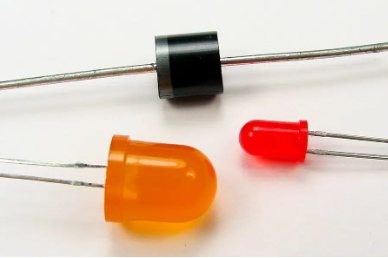Difference between Diode and Triode in PCBA manufacturing
In printed circuit board assembly (PCBA) manufacturing, understanding the differences between diode and triode is crucial for designing efficient electronic circuits. Both components play essential roles in controlling the flow of electrical current, but they have distinct characteristics that determine their specific applications and functionalities.

Diode:Diode
A diode is a two-terminal electronic component that primarily allows current to flow in one direction while blocking it in the opposite direction. Here are key characteristics and uses of diodes in PCBA manufacturing:
1. Functionality: Diodes are used for rectification, converting AC (Alternating Current) to DC (Direct Current). They ensure that current flows in only one direction, preventing reverse polarity which can damage sensitive components.
2. Types: Common types include:
– Rectifier Diodes: Used in power supplies to convert AC to DC.
– Zener Diodes: Maintain a constant voltage for regulation.
– Light-Emitting Diodes (LEDs): Emit light when current flows through them, used for indicators and displays.
3. Applications: Diodes are found in almost all electronic circuits:
– Power supplies
– Signal demodulation
– Overvoltage protection
– Voltage regulation
Triode (Transistor):Triode
A triode, also known as a transistor, is a three-terminal semiconductor device that amplifies or switches electronic signals and electrical power. Here are the key characteristics and uses of triodes in PCBA manufacturing:
1. Functionality: Triodes can amplify current, acting as switches or amplifiers depending on the configuration:
– Bipolar Junction Transistors (BJTs): Amplify current and are used for analog circuits.
– Field-Effect Transistors (FETs): Control current flow with an electric field, used in digital circuits.
2. Types: Different types cater to specific applications:
– NPN and PNP BJTs: Common bipolar transistor types.
– MOSFETs (Metal-Oxide-Semiconductor Field-Effect Transistors): High-speed switching in digital circuits.
– JFETs (Junction Field-Effect Transistors): Used in amplifiers and analog switches.
3. Applications: Triodes are essential in modern electronics:
– Amplifiers in audio systems
– Switching circuits in digital logic gates
– Oscillators in radio frequency applications
– Drivers for motors and relays
Comparison– Function: Diodes primarily control current direction, whereas triodes amplify or switch currents.
– Configuration: Diodes are two-terminal devices, while triodes (transistors) have three terminals: emitter, base, and collector.
– Applications: Diodes are crucial for power supply and signal processing, while triodes are fundamental in amplification and digital switching.
In conclusion, while diodes and triodes are both essential components in PCBA manufacturing, their distinct functionalities and applications make them suitable for different roles within electronic circuits. Understanding their differences is key to designing and assembling efficient and reliable electronic devices.
在线留言询价
- 一周热料
- 紧缺物料秒杀
| 型号 | 品牌 | 询价 |
|---|---|---|
| MC33074DR2G | onsemi | |
| TL431ACLPR | Texas Instruments | |
| RB751G-40T2R | ROHM Semiconductor | |
| BD71847AMWV-E2 | ROHM Semiconductor | |
| CDZVT2R20B | ROHM Semiconductor |
| 型号 | 品牌 | 抢购 |
|---|---|---|
| IPZ40N04S5L4R8ATMA1 | Infineon Technologies | |
| STM32F429IGT6 | STMicroelectronics | |
| BP3621 | ROHM Semiconductor | |
| ESR03EZPJ151 | ROHM Semiconductor | |
| TPS63050YFFR | Texas Instruments | |
| BU33JA2MNVX-CTL | ROHM Semiconductor |
- 周排行榜
- 月排行榜
AMEYA360公众号二维码
识别二维码,即可关注


请输入下方图片中的验证码:






















